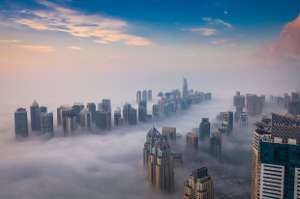Using AI to control energy for indoor agriculture
30 September 2024
Published online 24 November 2022
A deep dive into satellite data reveals factors that contribute to protracted fog events in the United Arab Emirates.

Although fog events are most common in the winter, they can occur year-round, and are particularly intense in the area around Abu Dhabi International Airport, which is immediately adjacent to a vast expanse of desert. When Francis first moved from Europe to the UAE in 2020, she was taken aback by the intensity of this fog. “I expected the climate to be dry year-round, being an arid country,” she says.
The local factors influencing these weather patterns are reasonably well understood. During the day, moist air from the coast travels inland, where it then becomes trapped overnight as the surface of the land cools rapidly. However, little is known about the larger-scale phenomena informing this process, and Francis and colleagues analysed 35 years of meteorological data—from 1983 to 2018—to get a better handle on these factors.
Over the span of the study period, the researchers counted more than 100 multi-day fog events, which they were able to connect with a set of well-studied patterns of atmospheric pressure and circulation. The most prominent of these, a system known as the East Atlantic/West Russia pattern, was linked with almost half of the tracked fog days. Their analysis also revealed that fog events were closely associated with high-pressure systems over the Arabian Peninsula. “This helps to better forecast long-lasting fog events,” says Francis.
Her team found that the frequency and duration of these multi-day fog events has increased in the past 20 years. On the other hand, it is also becoming less dense and opaque, and covering a smaller land surface area. This suggests a meaningful change in the structure and composition of the fog that has developed over the UAE in recent years, and Francis is now looking to take a deeper dive into the chemical and physical properties of the water vapour in contemporary fog events.
doi:10.1038/nmiddleeast.2022.75
Fonseca, R. et al. Regional atmospheric circulation patterns driving consecutive fog events in the United Arab Emirates. Atmospheric Res. 282, 106506 (2023).
Stay connected: